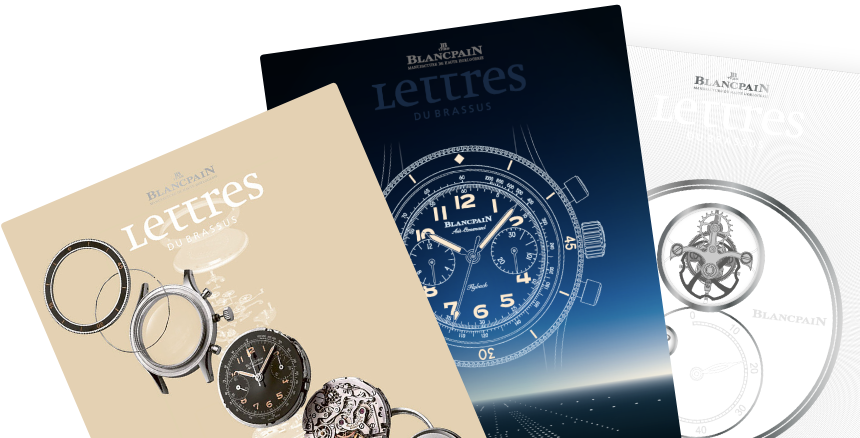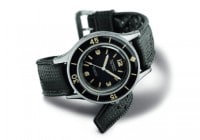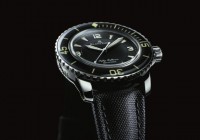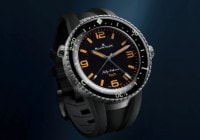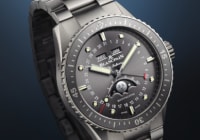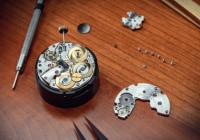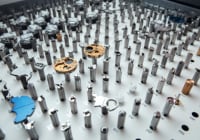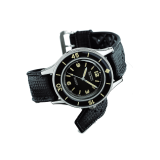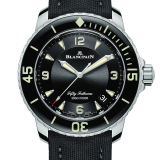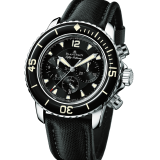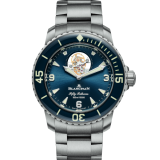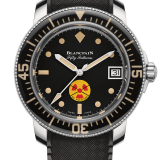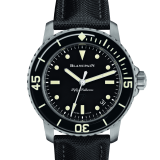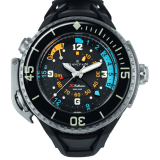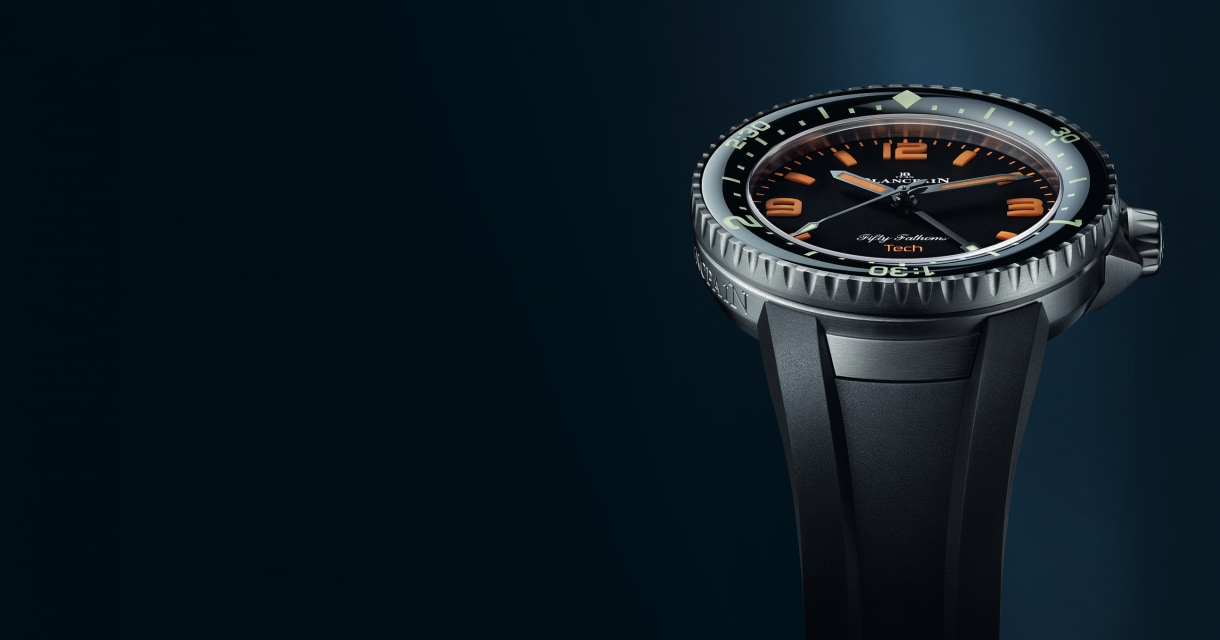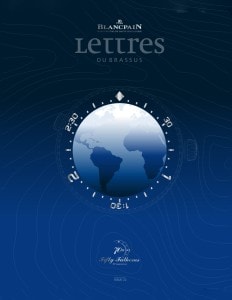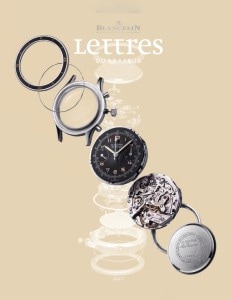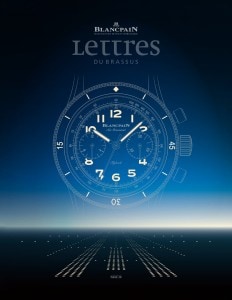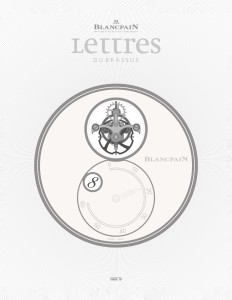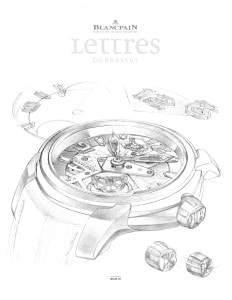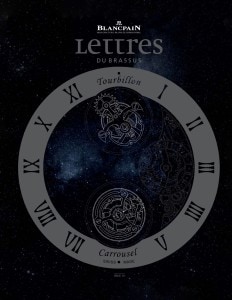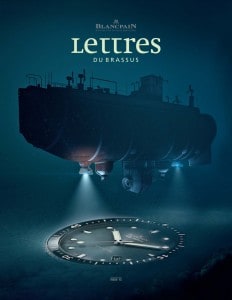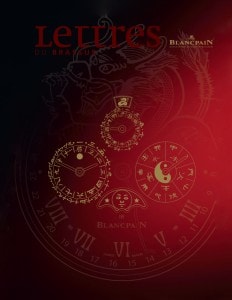
Search in Issues
Chapters
List of parts
Chapter 2
THE FIFTY FATHOMS A retrospective 20 years after its rebirth
Over the past 20 years, the Fifty Fathoms has established itself as a pillar of Blancpain.
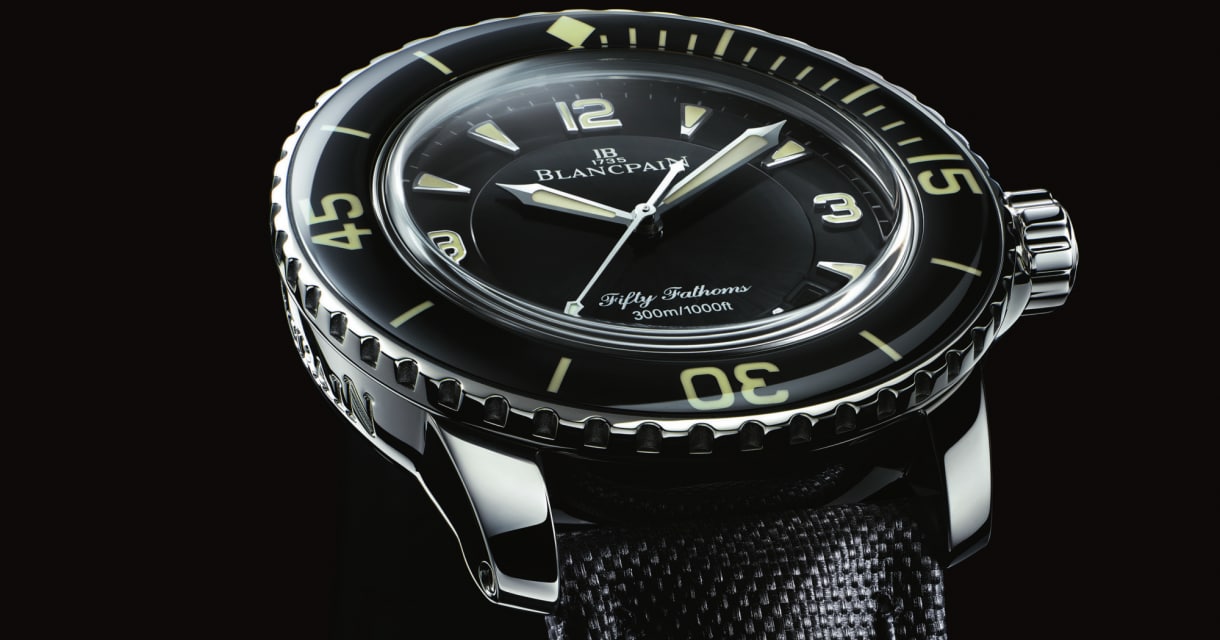
Discovering examples of VINTAGE FIFTY FATHOMS from the 1950s and 1960s in Blancpain’s vault, and being immediately seduced by their charm, Marc A. Hayek vowed, in his words, “TO BRING BACK ALIVE” this history and tradition.
What do the last 20 years of the Fifty Fathoms signify for Blancpain? In the words of CEO Marc A. Hayek, “they have made Blancpain complete”. That is a bold statement; one not casually proclaimed. However, pulling the focus back from 20 years to embrace a period many decades longer reveals the clarity of his perspective.
When Blancpain’s then Co-CEO Jean-Jacques Fiechter created the Fifty Fathoms 70 years ago, he was no less than an iconoclast. It was the world’s first real diving watch. Yes, there were some earlier attempts by others to develop diving watches, but they all missed the mark. Fiechter understood the problem in ways that had eluded others. He was a passionate diver in an era when diving was largely the province of professionals, overwhelmingly then military, with but a very few adventuresome amateurs. His personal experiences as a diver, including running out of air while on a dive, illuminated the requirements demanded by the underwater world. He poured his insights from his diving training into the watch, introducing a patented system for protecting the case-back seal, a novel system for the crown seal (also patented), a large size and white luminous hands and markings against a black background for readability, a locking rotating bezel for the timing of dives, and automatic winding to protect against wear of the crown. Not only was the resulting Fifty Fathoms the first watch in the world to offer these features and designs, it set the enduring standard for what a diving watch had to be. Soon, the Fifty Fathoms was adopted by leading militaries around the world: France, the United States, Germany, Israel, Norway, and many others. So perceptive were Fiechter’s ideas, the Fifty not only defined the genre of diving watches for the entire watch world during its initial era, it has done so ever since.
But Fiechter’s creation also represented something else for Blancpain—subtle perhaps when measured against the clarity and importance of his vision for the entire diving watch category, but upon reflection, equally vital. When Fiechter developed the Fifty Fathoms, it was during a time when the rest of the watch industry had essentially turned its back on even considering making a diving watch. Indeed, the leading French watch company at the time went so far as to decline to make a diving watch for the French Navy, declaring “diving watches have no future”. Fiechter was in all respects a contrarian, ignoring the trends and fashion at the time that favored dress and aviation watches.
Having confidence in its vision, even if it means going against fashion as Fiechter did when he conceived the Fifty Fathoms, has been woven into Blancpain’s DNA. In that sense, history repeated itself when Jacques Piguet, then the owner of the renowned Vallée de Joux movement house Frédéric Piguet, purchased Blancpain and enlisted Jean-Claude Biver as CEO in the early 1980s. At the time, the Swiss mechanical watch industry was under siege from inexpensive quartz watches. Industrywide, the response had been to abandon complicated watches in an effort to reduce costs in what became a failed attempt to compete with quartz on price. Piguet and Biver had a contrary vision. Going against the mainstream as Fiechter had done, they saw the romance, art, and wonder of fine complications and took Blancpain in that direction, beginning with the introduction of moon-phase timepieces followed by the creation of all of watchmaking’s revered traditional complications. The progression culminated with the 1735, a grande complication timepiece that made its mark upon its debut as the most complicated automatic winding wristwatch in the world.
The Piguet/Biver era of Blancpain that lasted two decades—focused as it was upon complicated and dress watches—put the evolution of the Fifty Fathoms on hold until the arrival of Marc A. Hayek. Like Fiechter decades before, Hayek was a passionate diver. Discovering the vintage Fifty Fathoms timepieces in Blancpain’s vault and immediately being seduced by the charm of Fiechter’s creations, Hayek vowed, in his words, “to bring back alive” this history and tradition. Some may see this as history turning back on itself, but in many ways the opposite is true. When Hayek determined to revive the Fifty Fathoms, he was following his instinct, vision, and passion in the face of practice at the time. Fashion had moved the watch world away from diving and sport watches. In this sense, it was not a bending back of history; it was continuing the straight line of Blancpain’s history, where each of its leaders (Fiechter, Biver, and now Hayek) trusted his vision notwithstanding contrary trends.
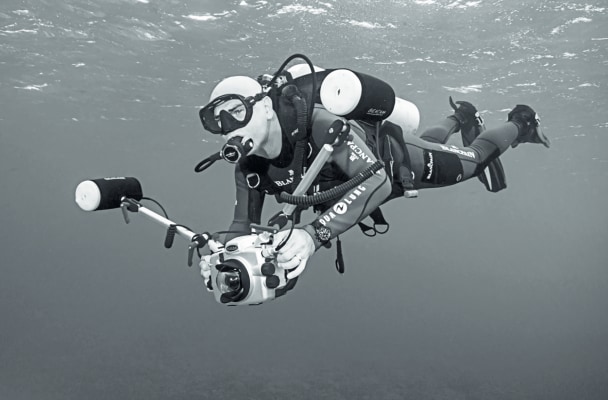
Current CEO Marc A. Hayek during a Gombessa expedition dive.
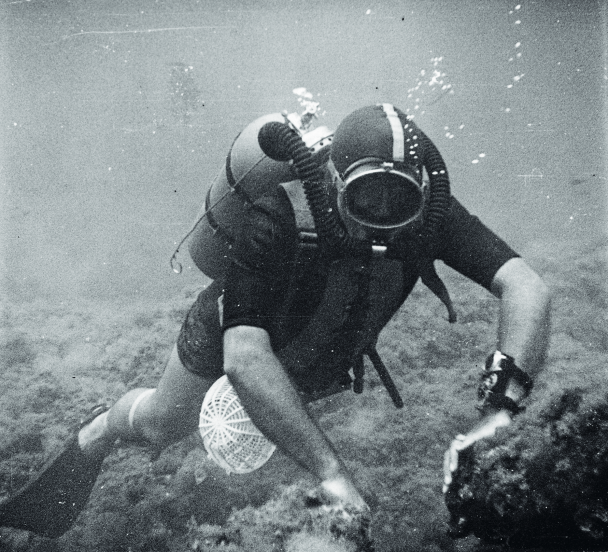
Former Blancpain Co-CEO Jean-Jacques Fiechter during a dive in the 1950s.
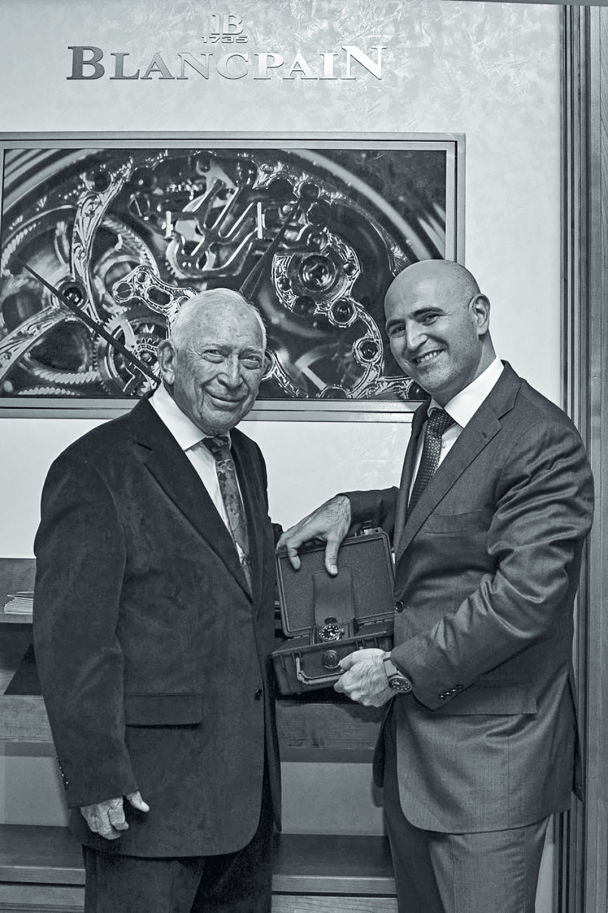
Two Blancpain eras together. Jean-Jacques Fiechter (left) and Marc A. Hayek (right).
2003 The first step in the REVIVAL OF THE FIFTY FATHOMS was the 2003 Anniversary model.
During the Fiechter era, the Fifty Fathoms was a key pillar for Blancpain, one that together with the Ladybird women’s line defined the house. Restoring the Fifty to its proper place at Blancpain was not something that would happen overnight. Hayek’s first step, on the occasion of the 50th anniversary of the Fifty, although modest in scope, signaled what was to come. In 2003, Blancpain released three series of 50 timepieces that captured the spirit of the vintage pieces, but with thoroughly modern innovations. The Anniversary series was fitted with a two mainspring barrel movement offering a 4-day power reserve and a bombé sapphire unidirectional rotating bezel.
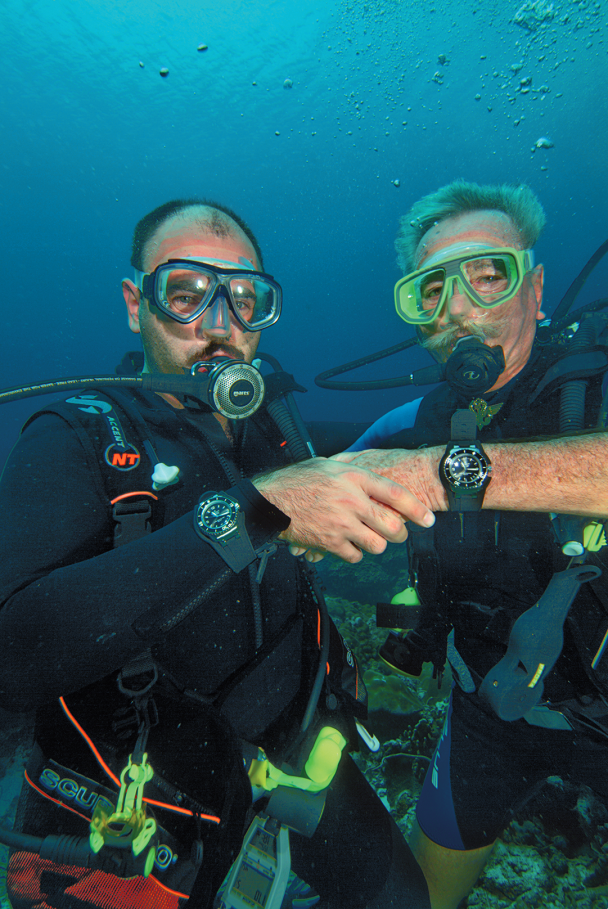
The launch of the 2003 Fifty Fathoms brought together Marc A. Hayek and Robert “Bob” Maloubier OBE, co-founder of the French Combat Diving Corps, during a dive in Thailand.
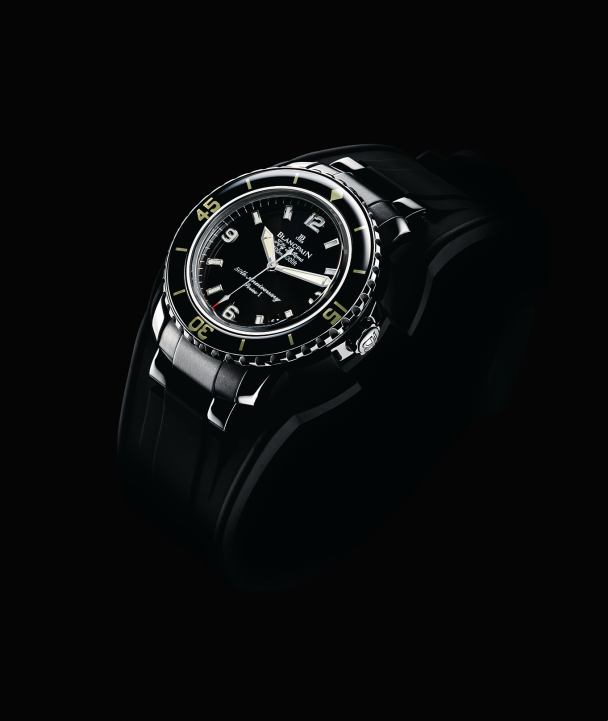
The 2003 Anniversary Fifty Fathoms. Equipped with both a metal bracelet and a large rubber strap for diving, the Anniversary model introduced the bombé sapphire bezel.
2007 saw the debut of the NEW GENERATION of FIFTY FATHOMS.
It took four more years after the launch of the Anniversary series until Blancpain was ready to debut the timepiece that embodied Hayek’s conception of a fully evolved Fifty Fathoms. He insisted that the new generation Fifty had to demonstrate Blancpain’s technical prowess, allow for no compromises in its diving functionality, while at the same time honoring the legacy of the vintage pieces from the 1950s. An entirely new high-performance movementwas developed for the 2007 Fifty Fathoms Automatique. The 1315 caliber boasted three mainspring barrels to achieve a 5-day power reserve, a free sprung inertially regulated balance for not only superior timing precision but also extra robustness and shock-resistance, and extra-large jewels and fine finishes bestowing the beauty of fine watchmaking to its sport milieu. The innovative sapphire bezel from the 2003 series also graced the 2007 Automatique. The bombé shape brought extraordinary presence to the luminous indexes painted on the back side and also promised scratch resistance second only to diamond. Any doubts about the place of the Fifty Fathoms in the overall collections of Blancpain were certainly erased with the simultaneous release alongside the Automatique of a Fifty Fathoms Chronographe Flyback with sealed pushers so that the chronograph could be used underwater and—the ultimate in diving watch luxury—a Fifty Fathoms Tourbillon.
At the time of the release of this trilogy of new Fifties, the mainstay of Blancpain’s collections were complicated and dress watches. There were voices that doubted the wisdom of Hayek’s commitment elevating the Fifty Fathoms to such prominence. Hayek knew that following trends was a road to nowhere. At the same time, he was a realist; he knew that it would take time and patience for people to understand what the new Fifty Fathoms pieces were, what they represented, and the history behind them.
It is doubtful that a non-diver could ever have conceived the development of these new models. Hayek knew from the earlier years of his diving career not only the importance of a diving watch as a key timing instrument for a diver, but the manner in which it would be used. That brought an extra dimension to his understanding beyond being a diver: the experience of having used and relied upon a diving watch before the advent of today’s dive computers.
Meeting with his colleagues at Blancpain during the development of new watches for the Fifty collection, Hayek has witnessed the different perceptions from those on his team who are divers and those who are not. Hayek and the others who have firsthand diving experience have an understanding of not only what a diving watch must have, but the “why”.
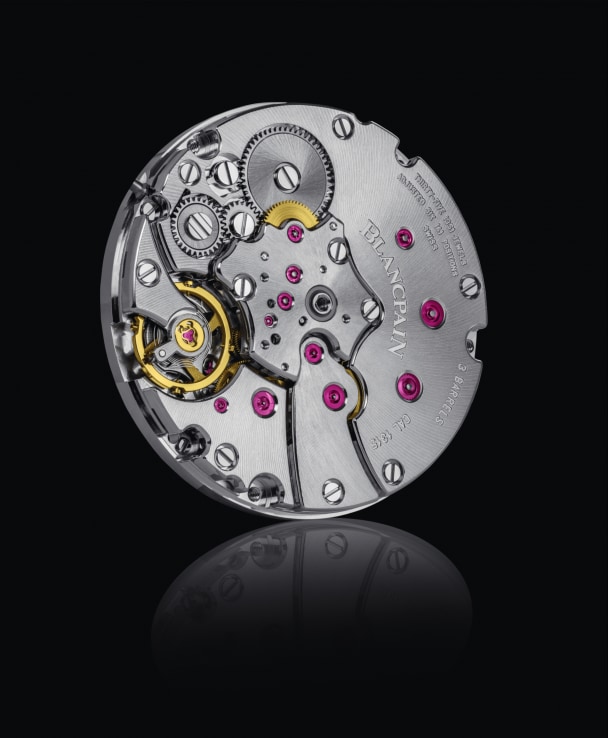
The caliber 1315 three mainspring barrel 5-day power reserve movement that powers the modern Fifty Fathoms Automatique.
2007 The debut of the new-generation Fifty Fathoms Automatique also saw the FIFTY FATHOMS BECOME A COLLECTION.
Joined with the brilliant history of the Fifty Fathoms, the 2007 releases formed the bedrock upon which Hayek could build. In the ensuing 15 years, Blancpain has broadened and deepened the Fifty Fathoms line, which now has become a full collection to stand alongside the traditional and classic Villeret models and women’s Ladybird models. There has been one polestar that Hayek has insisted guide the development of every new model: the Fifty Fathoms was created as a dive watch, and every variation must fulfill that mission. This touchstone endures even as dive watches for many owners are prized as sport-chic timepieces as much at home with a suit as with jeans. Said another way, although they could, many of today’s owners may never dive with their Fifty Fathoms. The demands of Hayek’s credo are clear: a chronograph could only be part of the Fifty Fathoms collection if it could be used during a dive; a calendar complication could only be included if its correctors were water-resistant; a rotating bezel useable for dive timing must be fitted on all models; underwater legibility must be ensured; and all movements must be robust, fitting to the sport environment. Hayek sums up these criteria thusly: “the Fifty Fathoms was originally developed without compromise in the 1950s” and so it must be for the modern watches.
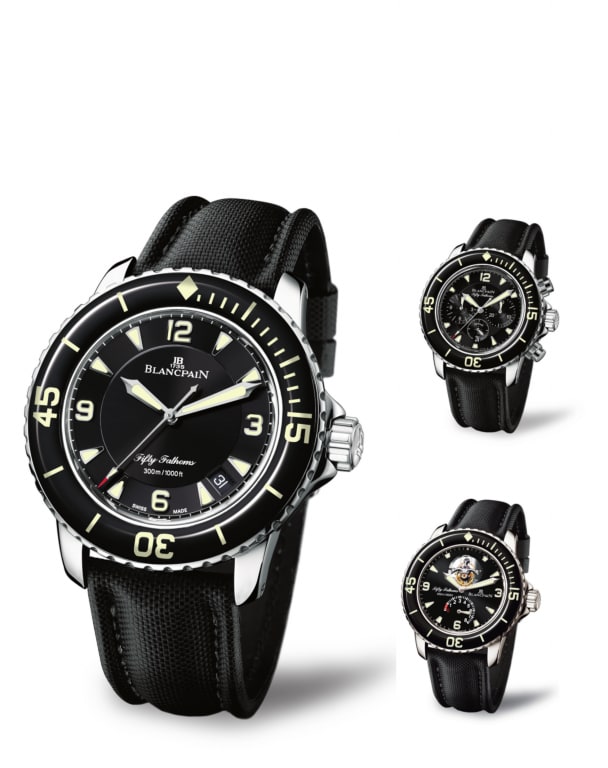
The trio of the 2007 launch, featuring the Automatique, the Chronographe Flyback and the Tourbillon.
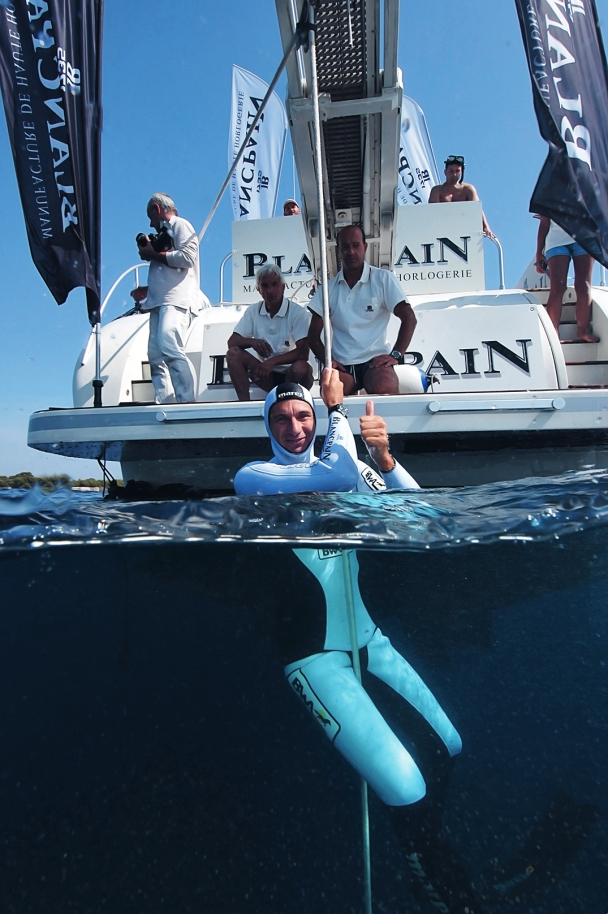
A highlight of the 2007 launch was a dive off the coast of southern France, during which freediving world champion Gianluca Genoni was given his Fifty Fathoms watch underwater.
2013 As was the case in the 1950s, Blancpain EXPANDED THE FIFTY FATHOMS COLLECTION by introducing a smaller sized model named the BATHYSCAPHE.
The first major broadening of the collection came in 2013 when Blancpain reintroduced the Bathyscaphe. In the 1950s, the Bathyscaphe came on the scene three years after the public launch of Fifty Fathoms. Keeping its dive watch pedigree with superior water resistance, legibility, and a rotating bezel for dive timing, the Bathyscaphe had two targets: a smaller size better suited for everyday wear (particularly important in an era when both men’s and women’s watches were generally quite small) and an even smaller size conceived to fit women’s wrists. Those same ideas apply to the modern Bathyscaphe. Hayek has overseen the creation of a wide variety of sizes for the Bathyscaphe to suit every taste. In addition, as Fiechter had done in his era, the Bathyscaphe has been enriched with complications. Fiechter offered Bathyscaphes with a simple date window and, later, one version with both a day of the week and date display. Hayek has gone further. The Bathyscaphe line includes not only the date (as do almost all of the Fifty Fathoms models) and a day of the week/date model, but more elaborate complications such as a complete calendar moon phase, an annual calendar, and a flyback chronograph.
The rich history from the ‘50s-70s became the inspiration for many variations in the modern Fifty Fathoms and Bathyscaphe lines. Examples include the “No Radiations” models, which feature the legend on the dial guaranteeing for civilians the absence of radioactive compounds required by some militaries for indexes and hands; the MIL-SPEC models echoing US Navy models, which incorporated a moisture indicator on the dial; the Aqualung series recalling the Fifty Fathoms timepieces that were sold alongside the full range of dive equipment in the Aqualung dive shops in France; the Barakuda that likewise draws upon the models sold by the Barakuda German diving equipment supplier; the Day Date 70s, with its roots coming from a 1970s watch with this complication; and the Nageurs du Combat honoring the long association between Blancpain and the French Combat Diving Corps.
The past 20 years have witnessed the introduction of a broad range of case materials. Beginning with stainless steel, which was the sole choice for the 2003 Anniversary Fifty, Blancpain progressively added red gold models for the Fifty Fathoms in 2007, followed by white gold, then expanded even more with choices in titanium, Sedna gold, and different colors of ceramic.
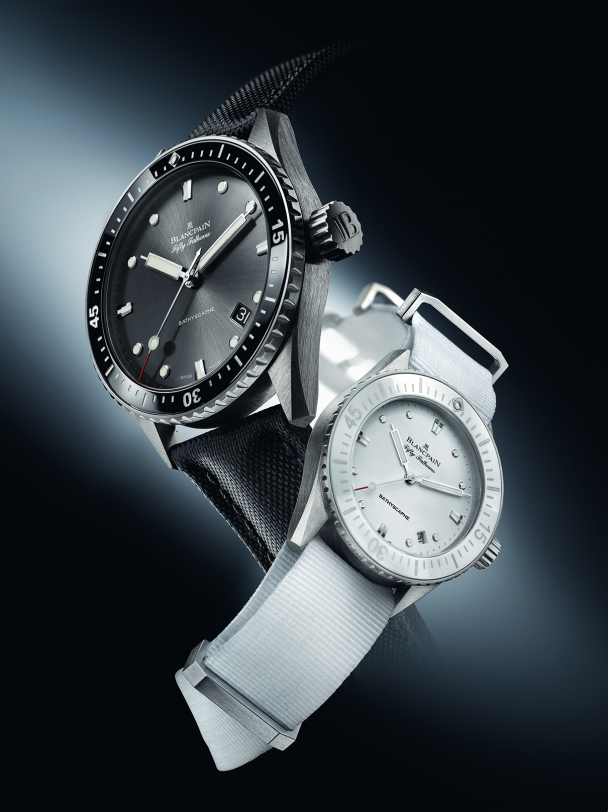
Two versions of the Bathyscaphe offering a choice of case sizes.
2012 The original Fifty Fathoms WAS REVOLUTIONARY for its time. In the same spirit, Blancpain developed the X FATHOMS as the MOST ADVANCED MECHANICAL DIVING WATCH IN THE WORLD.
With the iconic Fifty Fathoms embodying the essence of a classic dive timing instrument and the Bathyscaphe representing the combination of everyday wear and diving capability, Hayek saw that there was still one more line to add to the collection: one offering highly technical extreme diving timepieces. The first of these was the 500 Fathoms released in 2009. With its extra-strong titanium case, extra-thick sapphire crystal, and helium relief valve, the 500 Fathoms boasted a depth rating of 1,000 meters. The second model was yet even more ambitious in its capabilities: the Blancpain X Fathoms, which boasted a combination of features never before seen in a purely mechanical diving watch. Employing cutting-edge technology, its movement incorporated a Liquid MetalTM membrane whose deformation under pressure enabled two depth gauges: one that measured depths up to 90 meters, the second a high-precision gauge up to 15 meters with an accuracy finer than the movement of a diver’s arm. It also featured a third depth hand to record the maximum depth encountered during a dive. Finally, the X Fathoms included a five-minute countdown timer to aid a diver in the timing of the safety stop during an ascent to the surface. This technical line has now expanded further with the new Fifty Fathoms 70th Anniversary Act 2: Tech Gombessa.
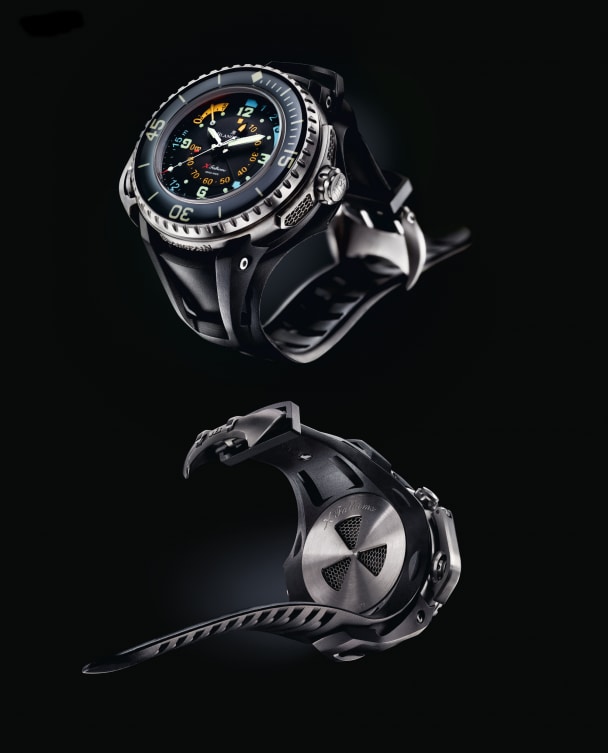
The X Fathoms, with its high-precision mechanical depth gauge.

Marc A. Hayek during the world debut of the X Fathoms at the aquarium located in the Dubai Mall.

Gianluca Genoni dressed as a watchmaker at the launch.
2003-2023 Over the past TWO DECADES the Fifty Fathoms HAS EVOLVED to become one of the MAINSTAYS of Blancpain.
Has the modern Fifty Fathoms collection been an overnight success? Most decidedly not. Its blossoming to become one of the mainstays of Blancpain has evolved over 20 years, patiently nurtured by Hayek’s vision and commitment. Hayek speaks of how he sees the Fifty Fathoms today: “The history is repeating itself a little bit. The Fifty Fathoms was a big success for Blancpain. It made Blancpain for several decades. We see today that the progress is here, the success of the line... I am very happy that it is repeating as it was in the ‘50s. As long as it might continue and work and as long as I am here, I will continue to push it, develop it, and cherish it.”
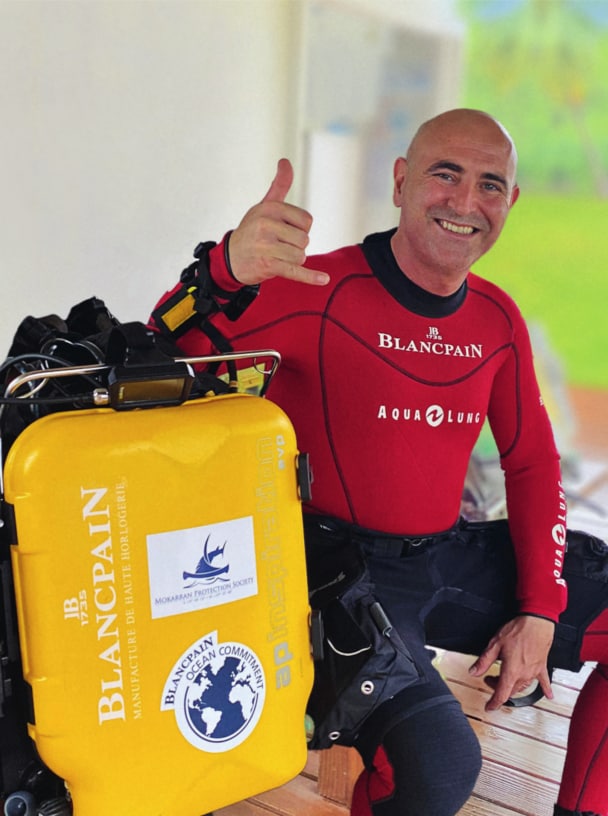
Marc A. Hayek landside during a diving expedition near Rangiroa in French Polynesia.
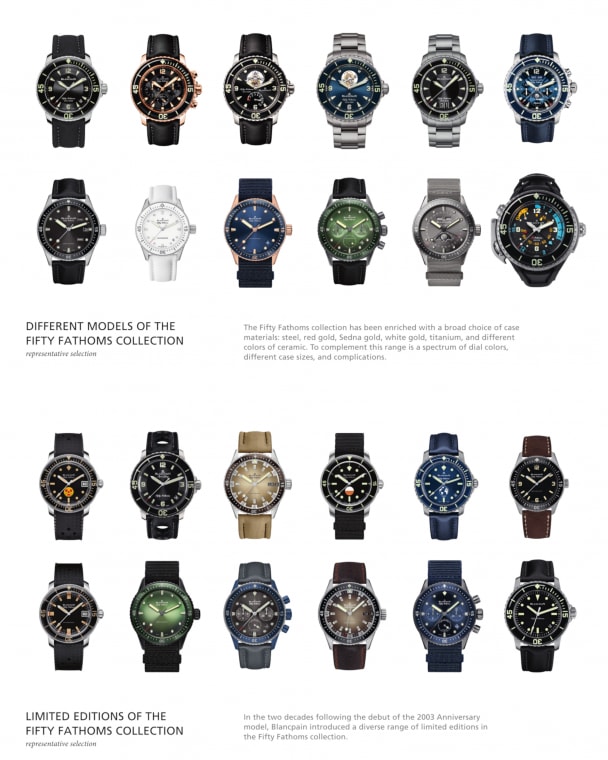
Other issues
Don't miss the latest issue
Sign Up for New Releases